1. Sate Varieties

Sate, also known as satay, is a delicacy that is central to Indonesian culinary culture. Satay consists of skewers of meat flavoured with spices that are grilled or barbecued and then served with a number of accompaniments. The skewers themselves are usually made from the midrib of the coconut palm frond or from bamboo. The meat type varies widely and may consist of diced or sliced chicken, goat, mutton, beef, pork, fish, tofu, eggs or minced blends. Bali’s own variant is sate lilit, made from minced beef, chicken, fish, pork, or even turtle meat, which is then mixed with coconut, coconut milk, and a rich blend of vegetables and spices. The accompaniments for satay skewers include spicy peanut sauce, as well as rice cakes or mixed slivers of cucumber and onion.
This is popular not only in Bali, but also across Indonesia and the entirety of Southeast Asia. Despite its widespread popularity, its origins lie in Indonesia and therefore the most authentic version of the dish can be found there.
With a skewer design that makes it easy to eat on the go, Satay is such a versatile and popular dish that there are many travelling vendors who sell it almost exclusively. It can be found from places like street-side restaurant tents to even high-class eateries.
| Next > |
2. Nasi Ayam and Nasi Campur
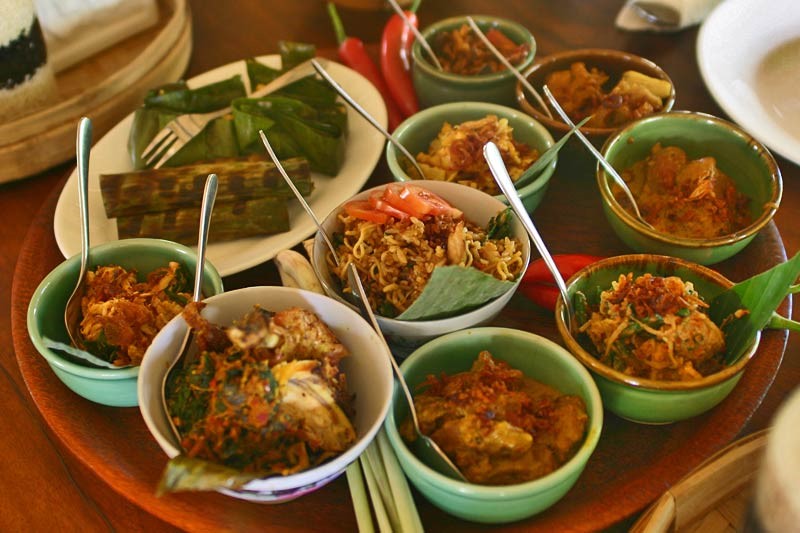
Nasi Ayam and Nasi Campur can be found served at many small eateries and restaurants throughout Bali. Also known to be Bali’s own take on ‘chicken rice’, the dish is mainly white rice served with many different elements of Balinese delights from babi buling or betutu as the main meats, together with mixed vegetables and a dab of the iconic spicy hot sambal matah. For those who do not want it too spicy, simply ask for it without the sambal.
| < Previous | Next > |
3. Bebek and Ayam Betutu
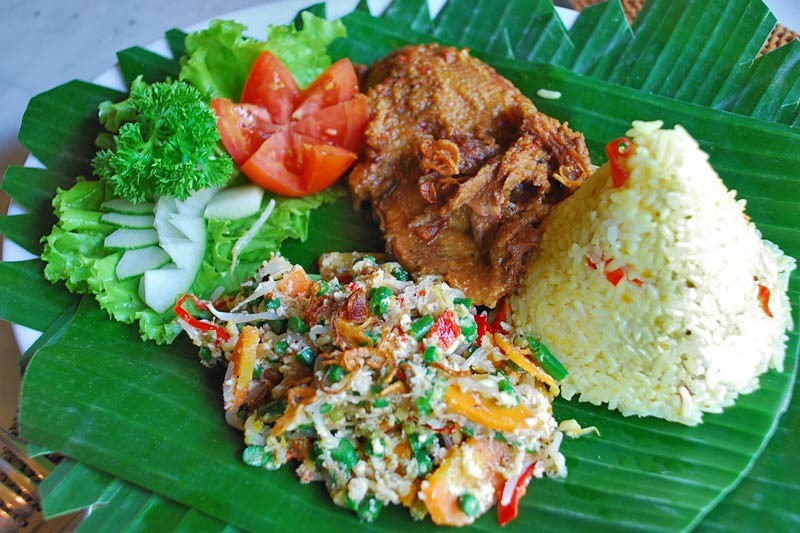
Betutu is the Balinese slow-cooked luscious equivalent of babi guling for ‘non-pork eaters’ and is also an iconic Balinese favourite. It consist of a whole chicken or duck stuffed with traditional spices, wrapped in banana leaves, then sealed tight in banana trunk bark before it’s baked or buried in a coal fire for 6 to 7 hours. The result is a rich and juicy, succulent feast with all meat easily separated from bones.
| < Previous | Next > |
4. Babi Guling (Suckling Pig)
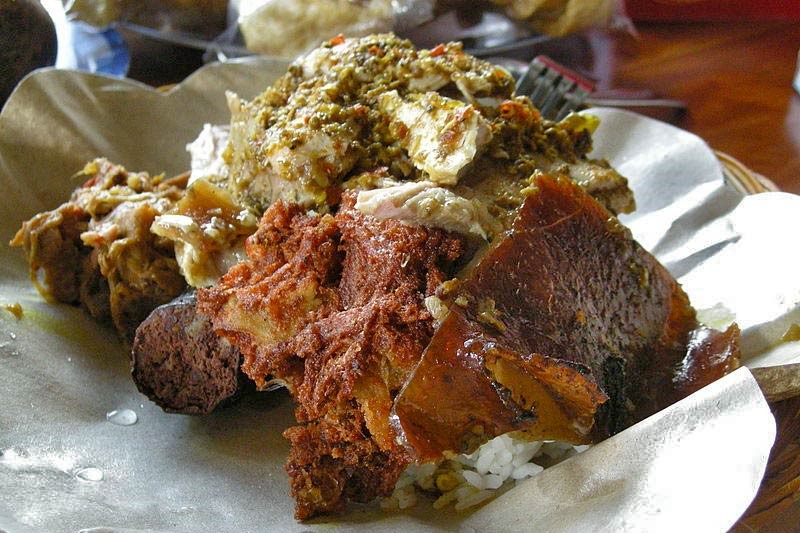
Also known as Balinese Suckling Pig, Babi guling is an all-time favorite especially for pork fanatics. It is one of the Island’s most famous dish - a pig is seasoned with local herbs and rich traditional spices then roasted whole. The skin would be crispy brown, while the meat would be tender and juicy. The tender meat is served on rice with stewed vegetables, pork sausage, fried pork meat and most importantly the crispy skin! At first, the dish was a communal treat only during special festivities and ceremonies, but now babi guling can be found widely from places like street-side restaurant tents to high-class eateries specializing in this dish.
| < Previous | Next > |
5. Tahu and Tempe
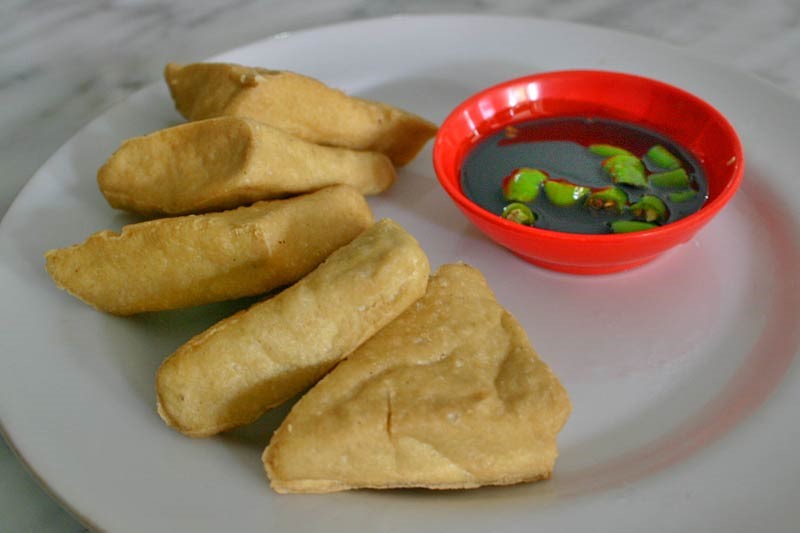
Tahu (tofu) and Tempe come in various preparations, these soy bean curds may be fried, stuffed and battered. Many Indonesian dishes include Tempe crackers, especially those that have the main portions of rice, while the most favorite Tahu snack are the stuffed and fried versions which usually include a mixture similar to spring rolls.
| < Previous | Next > |
6. Jimbaran Seafood

Muaya beach in Jimbaran Bay has beachside cafés that typically serves grilled fresh caught seafood, ranging from shrimp, clams, crabs, calamari, lobsters and a wide assortment of fish. Each café owners has their own secret recipes in terms of barbeque sauce and condiments. From sweet-sour blends to the typical hot and spicy. Taste it to believe it!
| < Previous | Next > |
7. Pepes and Tum
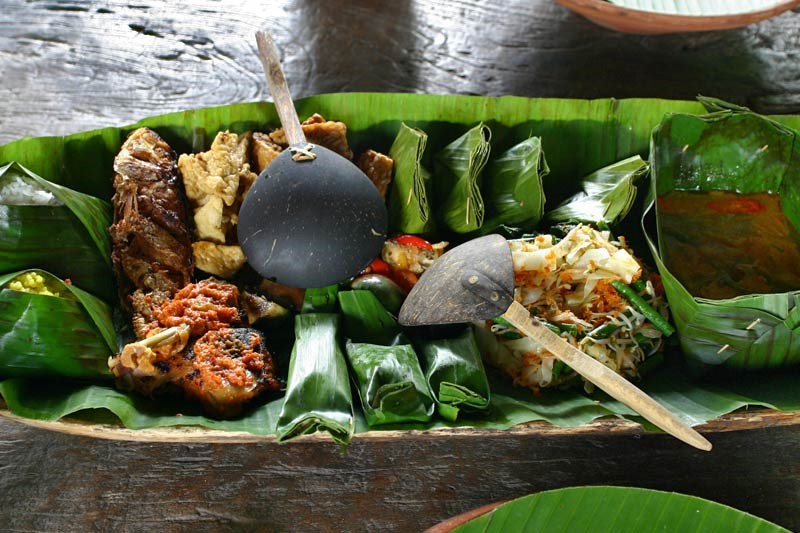
Pepes is a small package cooked by the Indonesian Sundanese cooking method using banana leaf as food wrappings and sewed with thin bamboo sticks at both ends. It is most commonly used to prepare fish as “pepes ikan” or meat, chicken, tofu or vegetables.
Tum takes on a different form, with the wrapping folded and stitched at one top end, and is usually steam-cooked. The banana-leaf wrapping provides a special aromatic appeal to the cooked blend.
| < Previous | Next > |
8. Lawar

Being a traditional mix, Lawar contains fine chopped meat, vegetables, grated coconut and spices. In some areas, lawar is prepared using fresh blood mixed with the meat and spices to enhance the flavor. It is usually served immediately after preparation as it cannot be kept for long. There are two main types of Lawar, red and white. The difference is that the white version usually does not contain any meat or blood.
| < Previous | Next > |
9. Nasi Goreng
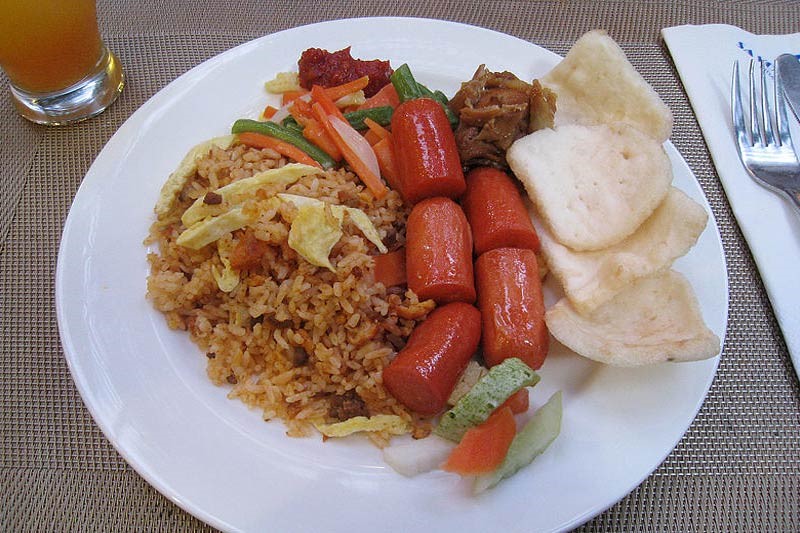
Nasi Goreng is perhaps one of the main dishes that defines the Balinese cuisine and is also a favourite throughout Indonesia. It is Indonesia's fried rice, one of many strong contenders for the position of Indonesia's national dish. Having been voted the second most delicious dish in the world by a 2011 CNN poll, nasi goreng is simple but incredibly delicious.
Nasi Goreng is pre-steamed rice stir-fried with a combination of meats and vegetables, with the presentation usually featuring the typical toppings of sliced tomatoes, cucumber, fried shallots, fish or shrimp cracker, mixed pickles or acar and usually mixed with a range of different spices, such as garlic, tamarind and chilli and sweet soy sauce to lend it a unique and delicious flavour. It is an integral part of larger meals and it can easily be combined with other ingredients ranging from scrambled eggs, diced beef, strips of chicken, shrimp, anchovies, lamb, crab, green peas, onions, shallots and a blend of sweet soy sauce or kecap manis and hot chili sauce.
| < Previous | Next > |
10. Gado-Gado

Gado-Gado is another popular choice for visitors interested in exploring the Balinese cuisine. This widely variegated dish is served all throughout Indonesia and can be either the main meal or just an accompanying side. Basically, it is a vegetable salad covered with a peanut sauce. Varying across the region, the most significant of which is whether or not the vegetables are cooked or raw, both are equally good depending on individual. The main key difference between this and traditional Western salads is the amount of sauce used - it should thoroughly coat the vegetables and not act as a form of dressing.
| < Previous |
|
Necessities Guide |
Top Attractions |
Top Foods |
|---|
